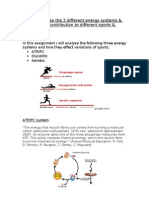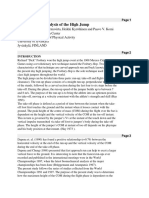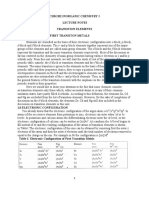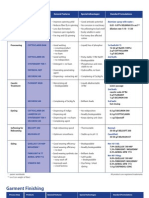Properties of Water Lab 2012a
Properties of Water Lab 2012a
Uploaded by
Fatien VioLet's SmilezsiieCopyright:
Available Formats
Properties of Water Lab 2012a
Properties of Water Lab 2012a
Uploaded by
Fatien VioLet's SmilezsiieOriginal Description:
Copyright
Available Formats
Share this document
Did you find this document useful?
Is this content inappropriate?
Copyright:
Available Formats
Properties of Water Lab 2012a
Properties of Water Lab 2012a
Uploaded by
Fatien VioLet's SmilezsiieCopyright:
Available Formats
LAB: Properties of Water
OBJECTIVES: Upon completion of this lab, you will:
• Explain that organisms must exchange matter with the environment to grow,
reproduce and maintain organization.
• Describe how water contributes to the fitness of the environment to support
life.
• Describe the structure and geometry of a water molecule, and explain what
properties emerge as a result of this structure.
• Explain the relationship between the polar nature of water and its ability to
form hydrogen bonds.
• List four characteristics of water that are emergent properties resulting from
hydrogen bonding.
• Describe the biological significance of the cohesiveness of water.
• Explain how water molecules dissociate and re-form, and the significance of
this dissociation and re-formation to the pH scale.
There is no doubt that water is vital to living organisms. Besides being the most plentiful chemical compound on the
Earth’s surface, water makes up roughly 50-95% of the composition of living cells, depending on their function and
nutrient content. As a chemical compound, water possesses some unique physical and chemical properties that make it
an ideal compound for life. In this lab activity, you will explore a few of water’s properties by performing some short
experiments that illustrate water’s importance to life.
MATERIALS:
Water Ethanol Glass microscope slide Piece of wax paper
Salt Sponge piece Dixie cups Fan
Beral pipets Granulated sugar Test tubes Balloon
Mineral oil Paper towels 400 mL beaker Penny
Molecular models of water pH paper Soapy water solution
Various solutions with differing pH levels
SAFETY: Alcohol is flammable and toxic. Keep away from sources of heat. Do not ingest! Also, dispose of alcohol as
your teacher directs.
WATER FORMS HYDROGEN BONDS
These weak bonds that collectively are very strong make possible most of water’s unique
properties, such as cohesive and adhesive properties, high specific heat, high heat of
vaporization and polarity. Hydrogen bonds are what are known as intermolecular forces—
attractive forces that act between particles that are next to one another. Specifically,
hydrogen bonds are weak bonds that form between hydrogen atoms of one molecule and
the lone pair(s) of neighboring electronegative atoms. This hydrogen bonding allows for
water molecules to be both adhesive (sticking to other surfaces) and cohesive (sticking to
From
http://course1.winona.edu/sberg/ILLU each other). Both the adhesive and cohesive properties of water are critical to living
ST/H-bond2.gif organisms, as water is able to reach the tops of the tallest trees due to adhesion and
cohesion. When water adheres to the xylem tissues of plants and “crawls” to the tops of
these plants, this is known as capillary action. Capillary action also occurs in non-living
objects, such as drinking straws and graduated cylinders.
Properties of Water Lab 2012
Modified from a lab by David Knuffke, Deer Park HS
Page 1 of 8
Activity 1A: Water’s Molecular Structure and Hydrogen Bonding
1. Using the molecular models provided for you by Water Molecule (space-filling model)
your instructor, sketch, color, and label a space-
filling model of water in the space provided. Be
sure it is an accurate representation of the actual
model! Give a description of the shape of the
water molecule.
2. Now, using your model, demonstrate for your
instructor what hydrogen bonding of multiple
water molecules to each other looks like. Get your
instructor’s approval of your model by having
him/her stamp in the space at right.
3. When you have received approval from your
instructor as to the correctness of your model,
label the diagram shown at right. Identify the
hydrogen bonds, the covalent bonds, and the
individual atoms and charges on at least one
individual water molecule.
Activity 1B: Capillary Action, Adhesion and Cohesion
1. Cut a strip of paper towel about 2 cm wide x 15 What happens to the paper?
cm in length.
2. Tape the strip of paper towel to a pencil.
3. Fill a 400 mL beaker with about 10 mL of water.
4. Now place the pencil with the paper towel strip
over the opening of the beaker so that the end of
the paper towel strip touches the surface of the
water. Wait for 5 minutes. How could this be applicable to living things?
5. When you are done making observations, answer
the questions at right and clean your workstation.
Properties of Water Lab 2012
Modified from a lab by David Knuffke, Deer Park HS
Page 2 of 8
Activity 1B Continued
1. At this station you will see two graduated Plastic Cylinder Glass Cylinder
cylinders—one plastic and one glass. Both hold
the same quantity of liquid.
2. Fill each graduated cylinder to the same volume:
25mL.
3. Observe how the meniscus reading differs in each
cylinder. Sketch what you see at right and make
qualitative observations about the water in each
cylinder.
4. Clean up your work area.
Qualitative Observations Qualitative Observations
QUESTION: Which cylinder demonstrates greater adhesive forces between it and the water inside? Justify your answer.
WATER IS POLAR
Water has both a positive and a negative charge on its molecular structure. This is due to
the unpaired electrons of the oxygen atom hanging out in its outer valence shell. There is
a slightly positive charge on the ends where the hydrogen atoms are. This unequal
sharing of electrons causes the water molecule to be polar. This enables it to dissolve
From almost anything. Contrary to popular belief, water is not a universal solvent, as it is unable
http://www.sciencebuddies.org/science- to dissolve nonpolar molecules such as lipids and some proteins. This property of water
fair-
projects/project_ideas/Chem_img007.gif
is critical to the formation of cell membranes, which are composed of phospholipids and
proteins.
Activity 2A: Polarity
1. Fill one test tube with 5 ml of water from the sink. Water Ethanol
Fill a second tube with 5 mL of ethanol.
2. Using a balance, mass out 0.5 grams of salt and Salt Sugar Salt Sugar
place this into the test tube of water and swirl it
around. Record your results in the data table at
right.
3. Repeat step 2, except place the salt into the test
tube containing ethanol.
4. Repeat this experiment with 0.5 grams of sugar.
Record your results in the data table at right.
5. Clean up your work area.
Properties of Water Lab 2012
Modified from a lab by David Knuffke, Deer Park HS
Page 3 of 8
QUESTION: In what liquids do the salt and sugar dissolve, and why? Justify your answer.
Activity 2B: Polarity
1. Using the Beral pipet, form a small puddle (about Behavior of water Behavior of water
the size of a dime) on a piece of wax paper. on wax paper on glass slide
2. Place the tip of the pipet in the center of the
puddle and slowly drag the tip of the dropper
around the wax paper.
3. Repeat this procedure for the glass microscope
slide and make note of your observations in the
table at right.
4. Clean up your work area.
QUESTION: Explain the behavior of the water as it is dragged across the wax paper and across the glass slide. Which
surface does the water cling to? Which surface is the water repelled by?
QUESTION: Objects that are attracted to water are said Hydrophilic Hydrophobic
to be hydrophilic (“water loving”), while objects that are
repelled by water are said to be hydrophobic (“water
hating”). Identify the hydrophilic and hydrophobic
surfaces in this activity.
Activity 2C: Polarity
1. Obtain 2 sauce cups. Place 2mL of water in one of Behavior of oil droplet Behavior of oil droplet
the cups. In the other cup, place 2 mL of alcohol. in water in alcohol
2. Use the Beral pipet provided to put a small drop of
mineral oil in each cup. Stir the mixture with a
toothpick and observe what happens to the drop.
Record your observations in the data table at right.
3. Dispose of your cups and liquids as your teacher
directs.
QUESTION: In what liquids does the oil dissolve, and why? Justify your answer.
Properties of Water Lab 2012
Modified from a lab by David Knuffke, Deer Park HS
Page 4 of 8
Activity 2D: Polarity
1. Inflate a balloon. Gently rub the balloon against Sketch of balloon and water stream from faucet:
your clothing.
2. Using the faucet at a sink (be sure to remove the
hose first!), turn on the water so that a slowly
running stream of water exits the faucet.
3. Bring the balloon close to the stream of water but
do not allow the balloon to touch the water.
4. Sketch what you see occurring in the space at
right and write a description of what you see
happening.
QUESTION: How does water’s polarity explain why the water behaves as it does in this activity?
WATER HAS A HIGH SURFACE TENSION
Because of the hydrogen bonds that hold water molecules to each other, this creates
a ‘net’ of water molecules that allows some organisms to walk on water, such as water
striders. The surface tension of water is also what allows water to bead up on waxy
surfaces of leaves and organisms with waterproof coatings. In order to clean clothes
or wash dirty dishes/hands, surface tension must be reduced so water can spread and
wet surfaces. Chemicals that are able to do this effectively are called surface-active
agents, or surfactants. They are said to make water "wetter." Surfactants perform
From
http://en.wikipedia.org/wiki/File:Dew_2.jpg other important functions in cleaning, such as loosening, emulsifying (dispersing in
water) and holding soil in suspension until it can be rinsed away. Surfactants can also
provide alkalinity, which is useful in removing acidic soils.
Activity 3A: Surface Tension
1. At this station, there are two pennies and two Trial Water Droplets Soapy Water Droplets
beakers of water: one with soap and one on Penny on Penny
without. 1
2. See how many drops of each solution you can 2
fit on the head of each coin. Repeat each of
3
these 3 times and record your data in the table
at right. Average
QUESTION: Which coin held more water droplets, and why? How does adding soap affect the number of drops of
liquid you can add to the penny in this experiment?
Properties of Water Lab 2012
Modified from a lab by David Knuffke, Deer Park HS
Page 5 of 8
Activity 3B: Surface Tension
1. At this station, there are two pennies and two Trial Water Droplets Alcohol Droplets
beakers: one with water, and the other with on Penny on Penny
alcohol. 1
2. See how many drops of each solution you can 2
fit on the head of each coin. Repeat each of
3
these 3 times and record your data in the table
at right. Average
QUESTION: Using the data you collected above, explain which liquid has the higher surface tension.
QUESTION: What is the relationship between surface tension and cohesion?
WATER HAS A HIGH HEAT OF VAPORIZATION
The heat of vaporization of water is 2260 J/g. This means that to change water from a
liquid into a gas, the water itself must absorb 2260 J of energy. As a comparison, the
alcohol we have been using in this lab has a heat of vaporization of 124 J/g. This
property of water is important because many organisms use evaporative cooling; or
the evaporation of water, in order to cool themselves off when they are hot. This is
why sweating is a great way to cool down on a hot day.
From
http://en.wikipedia.org/wiki/File:Heat_of_Vap
orization_(Benzene%2BAcetone%2BMethano
l%2BWater).png
Activity 4: High Heat of Vaporization
1. Get a piece of sponge and rub some water on the Water Alcohol swab
inside of your forearm. Time to dry Time to dry
2. Place your moistened arm in front of a fan, and
time how long it takes for the water to completely
evaporate so that your arm is dry.
3. Repeat this activity with an alcohol swab. Record
your data in the data chart at right.
QUESTION: Which liquid appears to dry faster, and why? Justify your answer.
Properties of Water Lab 2012
Modified from a lab by David Knuffke, Deer Park HS
Page 6 of 8
WATER IS LESS DENSE AS A SOLID THAN IT IS AS A
LIQUID
When frozen, water molecules spread themselves apart in
a latticework (see picture at left). This creates air spaces in
the resulting solid that cause the ice that forms to be less
dense than the liquid water it originated from. This is
essential to organisms that live where it is always cold. The
ice floating on top of bodies of water provides insulation
for the life below and prevents organisms’ bodies from
freezing solid in the winter.
Activity 5: Density
1. You will see two water-filled tubs, each with an Tub #1 Tub #2
“ice balloon” inside.
2. In the space at right, describe the behavior of the
ice balloon in each tub.
QUESTION: Explain the behavior of the ice balloons in each of the tubs of water. Which tub contained salt water?
How do you know?
Properties of Water Lab 2012
Modified from a lab by David Knuffke, Deer Park HS
Page 7 of 8
WATER DISSOCIATES INTO HYDROXIDE AND HYDROGEN IONS
Most chemical reactions in organisms involve solutes dissolved in water.
So that we better understand chemical reactions, we need to know how
many atoms and molecules are involved in those reactions. To do this, we
must work in units that make working with molecules easier to quantify. In
chemistry, the unit of measure when dealing with quantities of molecules
is the mole. Recall that one mole represents Avogadro’s number of
molecules: 1 mole = 6.02 x 1023 molecules of a substance.
Water molecules exist in equilibrium between hydrogen ions and
hydroxide ions:
from http://www.biologycorner.com/resources/dissociation.gif H2O H+ + OH-
What this ultimately means is that the concentration of both of these ions
is equal to one another, at 1 x 10-7 M. In any aqueous solution at 25° C,
the product of the H+ and OH- concentrations is constant at 10-14 M. To
find this, simply add the [H+] value and the [OH-] value together. It will
always be equal to 10-14 M, regardless of what the individual
concentrations are.
When acids or bases are added to a solution of pure water, the
equilibrium of H+ ions and OH- ions is disturbed and will shift. If acids are
added to water, then the [H+] will increase and the [OH-] will decrease. If
bases are added to water, then the [OH-] will increase, and the [H+] will
decrease.
The concentrations of hydrogen and hydroxide ions are the basis for the
pH scale, which is used to describe how acidic or basic a solution is. If a
solution has a [H+] of less than 10-7 M, then it is considered to be basic. If
a solution has a [OH-] of greater than 10-7 M, then it is considered to be
basic. If a solution has a [H+] = [OH-], where both have concentrations of
from 10-7 M, then the solution is considered to be neutral.
http://www.epa.gov/acidrain/education/site_students/images/
phscale.gif
Because the pH scale is a logarithmic scale, each pH unit represents a 10-
fold difference in ion concentration. Thus, a solution of pH 3 is not 3
times more acidic than a solution of pH 6; it is 1,000 times more acidic.
Water molecules also dissociate into hydroxide and hydronium (H3O+)
ions, but its existence as these two ions is very short-lived.
Activity 6: Measurement of pH
1. You will see several different solutions at this Solution pH Acid, base,
station. neutral?
2. To measure the pH of each solution, do the Spring water
following: Ammonia
a. Use the pipet in each solution to place a Vinegar
drop of the solution on the pH paper Lemon juice
provided. Bicarbonate
b. Wait for 1 minute, then compare the paper
Tap water
strip to the color scale provided.
Properties of Water Lab 2012
Modified from a lab by David Knuffke, Deer Park HS
Page 8 of 8
You might also like
- Ion Worksheet KEYDocument1 pageIon Worksheet KEYAna Marie Corales Tabunar100% (1)
- Exercise LabDocument3 pagesExercise LabJonatan LeflerNo ratings yet
- Inside Zone Keith GrabowskiDocument52 pagesInside Zone Keith Grabowskigrid44No ratings yet
- Biol 308 - Study QuestionsDocument47 pagesBiol 308 - Study QuestionsDivya100% (1)
- Cannoly CanalDocument15 pagesCannoly CanalArya SreeNo ratings yet
- Chloride Metallurgy 2011Document34 pagesChloride Metallurgy 2011Manojlovic Vaso100% (1)
- Properties of Water Station LabDocument8 pagesProperties of Water Station LabZakaria HashiNo ratings yet
- Ens Ug TnauDocument266 pagesEns Ug TnauGanesh SarodeNo ratings yet
- 123Document52 pages123KUNAL ShahNo ratings yet
- Kinematic Analysis of The Powerlifting Style Squat and Conventional DeadliftDocument7 pagesKinematic Analysis of The Powerlifting Style Squat and Conventional Deadliftحسين جاموسNo ratings yet
- Fish DissectionDocument5 pagesFish DissectionAveriel SalemNo ratings yet
- 2013 LSU Coaching Clinic Notes PDFDocument4 pages2013 LSU Coaching Clinic Notes PDFthrowtherockNo ratings yet
- Phylum Chordata: (Some Invertebrates and All Vertebrates)Document60 pagesPhylum Chordata: (Some Invertebrates and All Vertebrates)nightingale1995No ratings yet
- CO-Role of ATP in Energy Coupling and TransferDocument46 pagesCO-Role of ATP in Energy Coupling and Transfermarianne.gugulan07No ratings yet
- SCIENCE DIgestive SystemDocument7 pagesSCIENCE DIgestive SystemRichard MerkNo ratings yet
- Skeletal Muscle and The Molecular Basis of Contraction-TextDocument23 pagesSkeletal Muscle and The Molecular Basis of Contraction-TextSuraj BisoiNo ratings yet
- Sliding Filament TheoryDocument9 pagesSliding Filament Theoryellandhae100% (1)
- Biomedik I DR - Susy Olivia: HomeostasisDocument57 pagesBiomedik I DR - Susy Olivia: HomeostasisAlbert TandyNo ratings yet
- Characteristics of Class AvesDocument4 pagesCharacteristics of Class AvesPriti Ranjan NarendraNo ratings yet
- Intro To Human Anatomy MartiniDocument63 pagesIntro To Human Anatomy MartiniSwitch GboiNo ratings yet
- Comparing VO2max Improvement in Five Training MethodsDocument27 pagesComparing VO2max Improvement in Five Training MethodsGabriel ZahariaNo ratings yet
- Overview of The Cellular Basis of Life: Chapter 1: The Human Body: An Orientation Part 1: CellsDocument26 pagesOverview of The Cellular Basis of Life: Chapter 1: The Human Body: An Orientation Part 1: CellsHans De GuzmanNo ratings yet
- Human AnatomyDocument92 pagesHuman Anatomymohamed.sewaNo ratings yet
- Animal BehaviorDocument35 pagesAnimal BehaviorCanjui0% (1)
- BIO 35 Chapter 3 - Movement and Muscle PhysiologyDocument15 pagesBIO 35 Chapter 3 - Movement and Muscle PhysiologyJake EverettNo ratings yet
- Strength and Conditioning EssentialsDocument13 pagesStrength and Conditioning EssentialsbetteratbeachserveNo ratings yet
- Structure of Skeletal MuscleDocument15 pagesStructure of Skeletal MuscleNoi Udi OlpsNo ratings yet
- Science and Practice of Strength Training 3rd Edition TEXTBOOKDocument13 pagesScience and Practice of Strength Training 3rd Edition TEXTBOOKlaboki218098No ratings yet
- Classification of MusclesDocument30 pagesClassification of MusclesAreej SadruddinNo ratings yet
- Cell Theory - Term PaperDocument16 pagesCell Theory - Term PaperPhyl MarylNo ratings yet
- Implementing and Practicing An Offensive Game PlanDocument6 pagesImplementing and Practicing An Offensive Game PlanbigcoachNo ratings yet
- Biomechanicks of Snatch Technique of Hghly Skilled and Skilled WeigthliftersDocument6 pagesBiomechanicks of Snatch Technique of Hghly Skilled and Skilled WeigthliftersStuarNo ratings yet
- Training For Strength and Hypertrophy - An Evidence-Based ApproachDocument14 pagesTraining For Strength and Hypertrophy - An Evidence-Based ApproachPrecision Wellness Precision WellnessNo ratings yet
- Boundless Lecture Slides: Available On The Boundless Teaching PlatformDocument80 pagesBoundless Lecture Slides: Available On The Boundless Teaching Platformragunath palaniswamyNo ratings yet
- A Technical Description of The Pull in WeightliftingDocument7 pagesA Technical Description of The Pull in WeightliftingpluckypuckNo ratings yet
- Energy Transfer During ExerciseDocument48 pagesEnergy Transfer During ExerciseHema Malini100% (1)
- NutritionDocument101 pagesNutritionAlexandra CardosoNo ratings yet
- BiochemistryDocument18 pagesBiochemistryShashanka PoudelNo ratings yet
- Biomechanics of The Javelin ThrowDocument18 pagesBiomechanics of The Javelin ThrowLucy ForwardNo ratings yet
- Histology of Muscles: Learning ObjectivesDocument5 pagesHistology of Muscles: Learning ObjectivesLP BenozaNo ratings yet
- PH and Buffer SystemsDocument7 pagesPH and Buffer SystemsVikki Anne CedoNo ratings yet
- Kinetic ChainDocument9 pagesKinetic ChainCarol LimaNo ratings yet
- Warming Up & Cooling Down FinalDocument29 pagesWarming Up & Cooling Down FinalROUF ALI MEERNo ratings yet
- Forces Acting On The OarDocument5 pagesForces Acting On The Oardaygo21No ratings yet
- LO5.1: Analyse The 3 Different Energy Systems & Explain Their Contribution To Different Sports & ActivitiesDocument6 pagesLO5.1: Analyse The 3 Different Energy Systems & Explain Their Contribution To Different Sports & Activitiesnbeer93No ratings yet
- Amino AcidsDocument32 pagesAmino AcidsStephen Leonel100% (1)
- Chronic Adaptations To TrainingDocument49 pagesChronic Adaptations To TrainingTan Sittan100% (1)
- Carbohydrate Metabolism in ExerciseDocument27 pagesCarbohydrate Metabolism in ExerciseMohdSyamRoslanNo ratings yet
- 8 Carbohydrate Metabolism PDFDocument36 pages8 Carbohydrate Metabolism PDFDayne Ocampo-SolimanNo ratings yet
- Physical Activity For LifeDocument36 pagesPhysical Activity For LifeHanah Grace Lopez100% (2)
- Notes - Chapter 3 - Cellular Level of OrganizationDocument7 pagesNotes - Chapter 3 - Cellular Level of OrganizationRogie P. BacosaNo ratings yet
- Lehninger Principles of Biochemistry 7th Edition All Chapters Instant DownloadDocument56 pagesLehninger Principles of Biochemistry 7th Edition All Chapters Instant Downloadxiafeifrody100% (4)
- The Effects of Exercise On Mental HealthDocument30 pagesThe Effects of Exercise On Mental Healthfnf102030No ratings yet
- Unit - I: Introduction To Environmental Studies and EcosystemDocument79 pagesUnit - I: Introduction To Environmental Studies and EcosystemDina GaranNo ratings yet
- Principles of Anatomy and Physiology in SportDocument37 pagesPrinciples of Anatomy and Physiology in SportOliviaMcCarthy6No ratings yet
- Biomechanical Analysis of High JumpDocument15 pagesBiomechanical Analysis of High JumpBen Wat100% (1)
- Amino Acids, Proteins, and EnzymesDocument17 pagesAmino Acids, Proteins, and EnzymesAna laura Flores100% (2)
- Muscles Used While RowingDocument4 pagesMuscles Used While RowingCristine EchaveNo ratings yet
- Aarr - Dec 2015Document16 pagesAarr - Dec 2015ToniG.EscandellNo ratings yet
- Introduction To RespirationDocument14 pagesIntroduction To RespirationAzneezal Ar-RashidNo ratings yet
- BSC ZoologyDocument18 pagesBSC Zoologykni_zoologyNo ratings yet
- 3.1.7 - The Biological Importance of WaterDocument60 pages3.1.7 - The Biological Importance of WaterduckzermcNo ratings yet
- A1.1-Water SCDocument51 pagesA1.1-Water SCBism4rckNo ratings yet
- Effectiveness of Using Polymers and Cement For Soil StabilizationDocument75 pagesEffectiveness of Using Polymers and Cement For Soil StabilizationRafiq MirNo ratings yet
- PEPolyethylene20 30GlassFilledDocument3 pagesPEPolyethylene20 30GlassFilledshizu monNo ratings yet
- General Chemistry 1: Quarter 1 - Module 1: Describing MatterDocument16 pagesGeneral Chemistry 1: Quarter 1 - Module 1: Describing MatterJohn Paul Recopuerto ParachaNo ratings yet
- Tutorial 3-Necleic AcidDocument4 pagesTutorial 3-Necleic AcidEngNo ratings yet
- Material Safety Data Sheet 1.: Chemical Product & Manufacturer'S DetailsDocument0 pagesMaterial Safety Data Sheet 1.: Chemical Product & Manufacturer'S DetailssahilchemNo ratings yet
- Requirements Concerning Pipes and Pressure Vessels: International Association of Classification SocietiesDocument69 pagesRequirements Concerning Pipes and Pressure Vessels: International Association of Classification SocietiesthanhNo ratings yet
- Carboxylic Acid Reductase 2015Document20 pagesCarboxylic Acid Reductase 2015bluedolphin7No ratings yet
- HDPE Liner WT For CS PipesDocument2 pagesHDPE Liner WT For CS Pipesmasdarto7032100% (1)
- Unit-4 - Chapters (1,2,3,4)Document10 pagesUnit-4 - Chapters (1,2,3,4)Farah AounNo ratings yet
- Chem Exercise 20 PDFDocument2 pagesChem Exercise 20 PDFUniversityJCNo ratings yet
- DIN 3015 ClampsDocument17 pagesDIN 3015 ClampsBalderas Rosas WilibaldoNo ratings yet
- 13 DPP 01a Mixed Boc ExcelDocument5 pages13 DPP 01a Mixed Boc ExcelKiller ẞunnyNo ratings yet
- Biofuels PresentationDocument9 pagesBiofuels Presentationronald100% (1)
- Devanathan (2,2018)Document6 pagesDevanathan (2,2018)YUVARAJAN DNo ratings yet
- CHM 202 Lecture IDocument9 pagesCHM 202 Lecture IDANIEL ODUNZENo ratings yet
- Carboguard 893 SG MIO PDSDocument4 pagesCarboguard 893 SG MIO PDSMuthuKumarNo ratings yet
- CARBORANESDocument10 pagesCARBORANESDRISTIE KALITANo ratings yet
- CAMPUS® Datasheet: Ultramid® T KR 4355 G5 - PA6T/6-GF25 BasfDocument6 pagesCAMPUS® Datasheet: Ultramid® T KR 4355 G5 - PA6T/6-GF25 BasfcurioushoainamNo ratings yet
- Emerging Methodologies & Technologies For Construction of Flexible PavementDocument32 pagesEmerging Methodologies & Technologies For Construction of Flexible PavementGobinder Singh VirdeeNo ratings yet
- Sequestering Agents FunctionsDocument4 pagesSequestering Agents FunctionsKushagradhi Debnath100% (5)
- OverviewDocument3 pagesOverviewcdhingra_1No ratings yet
- Catalysts 12 00717 v2Document31 pagesCatalysts 12 00717 v2Kiel JohnNo ratings yet
- BASF 13XBF-Molecular-Sieve Datasheet Rev.08-2020Document2 pagesBASF 13XBF-Molecular-Sieve Datasheet Rev.08-2020mrsina.ab1997No ratings yet
- CH CH CH - CH CL CL N N: PolymerizationDocument40 pagesCH CH CH - CH CL CL N N: PolymerizationAkash Yadav100% (1)
- National Drug Register of Uganda Human Herbal Medicines June 2020Document23 pagesNational Drug Register of Uganda Human Herbal Medicines June 2020Baguma MichaelNo ratings yet
- CE Series Manual 2015Document61 pagesCE Series Manual 2015Carl AzzopardiNo ratings yet
























































































